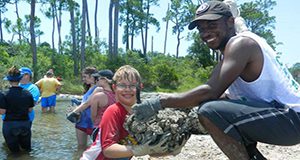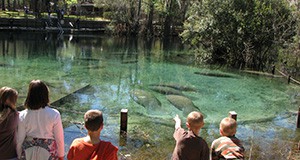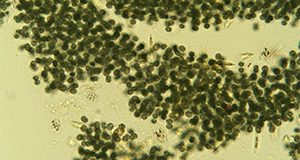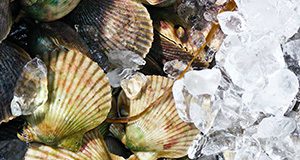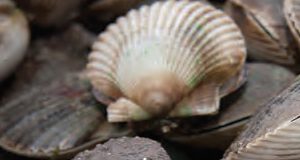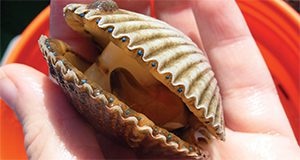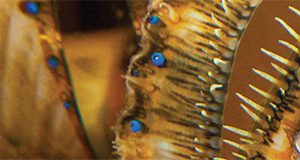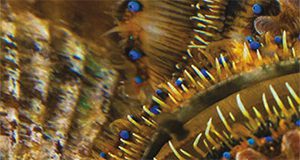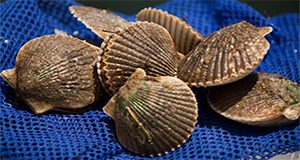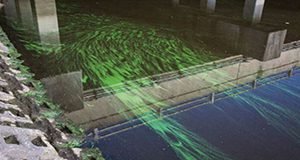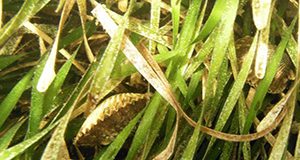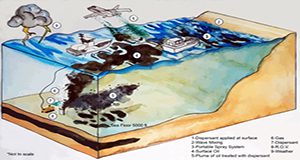Living shorelines are coastal shoreline stabilization interventions that rely on natural elements such as native vegetation and oyster reefs to protect property. The US Army Corps of Engineers, among other entities, regulates the placement of living shorelines through a permitting process to ensure project activities do not conflict with the public interest. In this 9-page guide, authors Savanna Barry, Sara Martin, and Eric Sparks provide you with example text for each application section that you can adapt to your needs to assist you in filling out the permit application. Published by the UF/IFAS Florida Sea Grant College Program.
http://edis.ifas.ufl.edu/sg189
Tag: Florida Sea Grant College Program
How Red Tides Impact Manatees
One of Florida's keystone species, manatees help to maintain healthy coastal and riverine ecosystems and are economically important for many coastal communities. Effective protection measures implemented in Florida for many years allowed state and federal regulators to reclassify manatees from Endangered to Threatened in 2017. Red tides, especially persistent blooms during winter months, can be one of the largest killers of Florida manatees, and they may become endangered again if they are subjected to increased mortality and stress. Understanding how red tides affect manatees and how can you help is critical. This 5-page fact sheet written by Brittany Hall-Scharf and Armando Ubeda and published by the UF/IFAS Florida Sea Grant College Program will explain what red tides are, how they harm manatees, and what you can do to help.
http://edis.ifas.ufl.edu/sg188
Dune Restoration and Enhancement for the Florida Panhandle
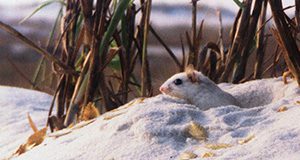
Published by the UF/IFAS Florida Sea Grant College Program, this manual provides an overview of the coastal ecosystems along the Florida Panhandle and shows how dunes can be restored and enhanced in this region of the Northern Gulf of Mexico.
In addition to direct experience acquired over many years of field work and experimentation, authors Chris Verlinde, Mack Thetford, and Debbie Miller consulted peer-reviewed academic journals, government documents, and various online resources to create the manual. Undergraduate and graduate students from the University of Florida and local professionals worked together with the UF/IFAS researchers to develop and test practical restoration techniques for Florida’s dunes.
http://edis.ifas.ufl.edu/sg156
Assessment of the Economic Impact Associated with the Recreational Scallop Season in Hernando County, Florida
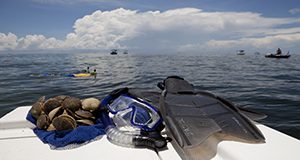
Recreational scalloping has become an increasingly popular activity within the Big Bend region of Florida, and Hernando County is the southern extent of healthy, harvestable bay scallop populations. State resource managers and County administrators expressed a need to know how the recreational scallop season impacts the local economies. This 10-page fact sheet written by Brittany Hall-Scharf, Charles Adams, Alan Hodges, and Stephen Geiger and published by the UF/IFAS Florida Sea Grant College Program and the UF/IFAS Food and Resource Economics Department presents results from a UF/IFAS study to determine the economic benefits derived from coastal and waterway access during recreational scalloping season in Hernando County.
http://edis.ifas.ufl.edu/sg161
Barotrauma and Successful Release of Fish Caught in Deep Water
If you catch a fish you are not going to keep, help it survive and get back to the deep! Throwing back your unwanted catch is good practice because healthy released fish can live to grow and reproduce, which benefits the fish population and the future of fisheries. But deepwater fish can have trouble getting back where they came from without a little assist from the angler. This 4-page fact sheet written by Betty Staugler, Holly Abeels, Angela Collins, Shelly Krueger, and Kai Lorenzen and published by the UF/IFAS Florida Sea Grant College Program describes barotrauma, a problem that, if left untreated, will kill otherwise perfectly healthy fish, and explains a few quick and simple methods to relieve fish suffering from barotrauma and help them get back home healthy and strong.
http://edis.ifas.ufl.edu/sg160
A Response to Frequently Asked Questions about the 2018 Lake Okeechobee, Caloosahatchee and St. Lucie Rivers and Estuaries Algal Blooms
Heavy rainfall with Hurricane Irma in 2017 and a rainy spring in 2018 set the stage for large-scale summer algal blooms in Lake Okeechobee and the St. Lucie and Caloosahatchee Rivers and Estuaries. Concerned residents and visitors flocked to social media. Authors Lisa Krimsky, Ed Phlips, and Karl Havens read their posts and tweets and now respond to concerns and questions about algal blooms in this 7-page fact sheet published by UF/IFAS Extension and the Florida Sea Grant College Program.
http://edis.ifas.ufl.edu/sg159
Best Practices for Scalloping: From the Boat to Your Plate
Recreational scalloping in Florida is a popular group activity for many residents and visitors throughout the summer months. This 6-page fact sheet written by Brittany Hall-Scharf, Sarah Ellis, and Savanna Barry and published by the UF/IFAS Florida Sea Grant College Program lists the legal requirements for boating and scalloping, provides a safety plan to minimize and/or prevent accidents while you’re out on the water, and explains proper shucking methods to ensure that the meals you make from your catch will be safe and delicious.
https://edis.ifas.ufl.edu/sg158
Recreational Harvesting of the Florida Bay Scallop: Taylor County
This useful brochure includes a full-color map identifying access routes to the boat ramps and marinas in southern Taylor County near Steinhatchee and Keaton Beach plus the latest information on scallops and scalloping, the recommended equipment you will want to bring, and a few tasty recipes for preparing Florida’s best summertime catch. Written by Victor Blanco and published by the UF/IFAS Extension Florida Sea Grant College Program.
http://edis.ifas.ufl.edu/sg146
Recreational Harvest of the Florida Bay Scallop: Hernando County
This useful brochure written by Brittany Hall-Scharf and published by the UF/IFAS Florida Sea Grant College Program includes a full-color map identifying access routes to the boat ramps and marinas in Hernando County. Also find the latest information on scallops and scalloping, the recommended equipment you will want to bring, and a few tasty recipes for preparing Florida’s best summertime catch.
http://edis.ifas.ufl.edu/sg148
Recreational Harvesting of the Florida Bay Scallop: Wakulla County
This handy brochure includes a full-color map identifying access routes to the boat ramps and marinas in Wakulla County, plus the latest information on scallops and scalloping, the recommended equipment you will want to bring, and a few tasty recipes for preparing Florida’s best summertime catch. Written by Savanna Barry and published by the UF/IFAS Extension Florida Sea Grant College Program.
http://edis.ifas.ufl.edu/sg149
Recreational Harvesting of the Florida Bay Scallop: Citrus County
This handy brochure written by Savanna Barry and published by the UF/IFAS Florida Sea Grant College Program includes a full-color map identifying access routes to the boat ramps and marinas in Citrus County near Homosassa and Crystal River, plus the latest information on scallops and scalloping, the recommended equipment you will want to bring, and a few tasty recipes for preparing Florida’s best summertime catch.
http://edis.ifas.ufl.edu/sg147
Recreational Harvesting of the Florida Bay Scallop: Pasco County
This useful brochure written by Brittany Hall-Scharf and published by the UF/IFAS Extension Florida Sea Grant College Program includes a full-color map identifying access routes to the boat ramps and marinas in Pasco County, plus the latest information on scallops and scalloping, the recommended equipment you will want to bring, and a few tasty recipes for preparing Florida’s best summertime catch.
http://edis.ifas.ufl.edu/sg157
Managing High Water Levels in Florida's Largest Lake: Lake Okeechobee
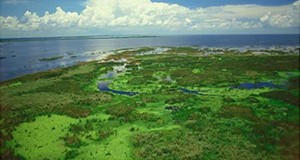
This 7-page fact sheet written by Karl E. Havens and published by the Florida Sea Grant College Program, UF/IFAS Extension, provides a history of Lake Okeechobee regulation schedules and an overview of the risks, constraints, and trade-offs that the US Army Corps of Engineers must consider when deciding to release flood water from the lake.
http://edis.ifas.ufl.edu/sg154
The Future of Harmful Algal Blooms in Florida Inland and Coastal Waters
Microscopic algae in oceans and inland waters sometimes grow to excessive levels called “blooms.” Warmer water temperatures and increased nutrient levels exacerbate blooms, and when nutrients are high, temperature increases of just a few degrees cause exponential increases of algae and blooms. This 4-page fact sheet written by Karl Havens and published by the Florida Sea Grant College Program and UF/IFAS Extension explains why algal blooms can be harmful and provides advice for communities seeking to reduce nutrient levels in their lakes, streams, and other bodies of water. In a warmer future, harmful algal blooms will be much more challenging to control than they are today.
http://edis.ifas.ufl.edu/sg153
Responsible Boating Protects Seagrass Meadows
Florida leads the country in the number of registered recreational watercraft, with between 867,463 and 921,834 vessels in the state. With so many people out enjoying Florida’s waters, there is significant risk of damage to sensitive coastal habitats such as seagrass meadows. This 4-page fact sheet written by Savanna Barry, Ana Zangroniz, and Joy Hazell and published by the UF/IFAS Florida Sea Grant College Program explains the importance of protecting seagrass meadows by responsible boating and gives tips to boaters about how to practice seagrass-safe boating.
http://edis.ifas.ufl.edu/sg151
Responsible Boating Protects Coral Reefs
Florida is often referred to as the boating capital of the nation, with more than 930,000 registered vessels. Florida’s numerous natural resources such as mangroves, seagrasses, estuaries and coral reefs are a major draw to resident and visiting boaters alike. Outdoor activities associated with boating, such as birding, fishing, swimming, snorkeling, and diving, contribute to the state’s economy. However, increased traffic on the water can bring potential risks, particularly to sensitive ocean bottom habitats such as coral reefs and seagrasses. This 4-page fact sheet written by Ana Zangroniz, Savanna Barry, and Joy Hazell and published by the UF/IFAS Florida Sea Grant College Program gives an introduction to the corals and coral reefs of Florida, provides ecological and economic information, and lists simple steps to ensure that safe boating practices reduce physical impacts on coral reefs.
http://edis.ifas.ufl.edu/sg152
Oil Spill Science: Sea Grant Programs of the Gulf of Mexico: Persistence, Fate, and Effectiveness of Dispersants used During the Deepwater Horizon Oil Spill
This 9-page fact sheet concerns the use of dispersants in response to the Deepwater Horizon (DWH) oil spill, the first spill that occurred in the deep ocean, nearly a mile below the surface. The large-scale applications of dispersants used at the surface and wellhead during the Deepwater Horizon oil spill raised many questions about dispersants and highlighted the importance of understanding their effects on the marine environment. Written by Monica Wilson, Larissa Graham, Christine Hale, Emily Maung-Douglass, Stephen Sempier, and LaDon Swann and published by the Florida Sea Grant College Program, the fact sheet was selected for publication on EDIS by Monica Wilson. Originally published at the National Sea Grant Library: https://eos.ucs.uri.edu/EOS_Linked_Documents/gomsg/EX-GOMRI-1%20-%20Wilson_M_2015.pdf
http://edis.ifas.ufl.edu/sg150
Recreational Harvesting of the Florida Bay Scallop: Citrus County
This publication includes a full-color map identifying access routes to the boat ramps and marinas in Citrus County near Homosassa and Crystal River, plus the latest information on scallops and scalloping, the recommended equipment you will want to bring, and a few tasty recipes for preparing Florida’s best summertime catch. Written by Savanna Barry and published by the Florida Sea Grant College Program.
http://edis.ifas.ufl.edu/sg147
Recreational Harvesting of the Florida Bay Scallop: Steinhatchee and Keaton Beach areas, Taylor County
A full-color map identifying access routes to the boat ramps and marinas in southern Taylor County near Steinhatchee and Keaton Beach, plus the latest information on scallops and scalloping, the recommended equipment you will want to bring, and a few tasty recipes for preparing Florida’s best summertime catch. Written by Victor Blanco and published by the Florida Sea Grant College Program.
http://edis.ifas.ufl.edu/sg146
Recreational Harvest of the Florida Bay Scallop: Hernando County
A full-color map identifying access routes to the boat ramps and marinas in Hernando County, plus the latest information on scallops and scalloping, the recommended equipment you will want to bring, and a few tasty recipes for preparing Florida’s best summertime catch. Written by Brittany Hall-Scharf and published by the Florida Sea Grant College Program.
http://edis.ifas.ufl.edu/sg148
